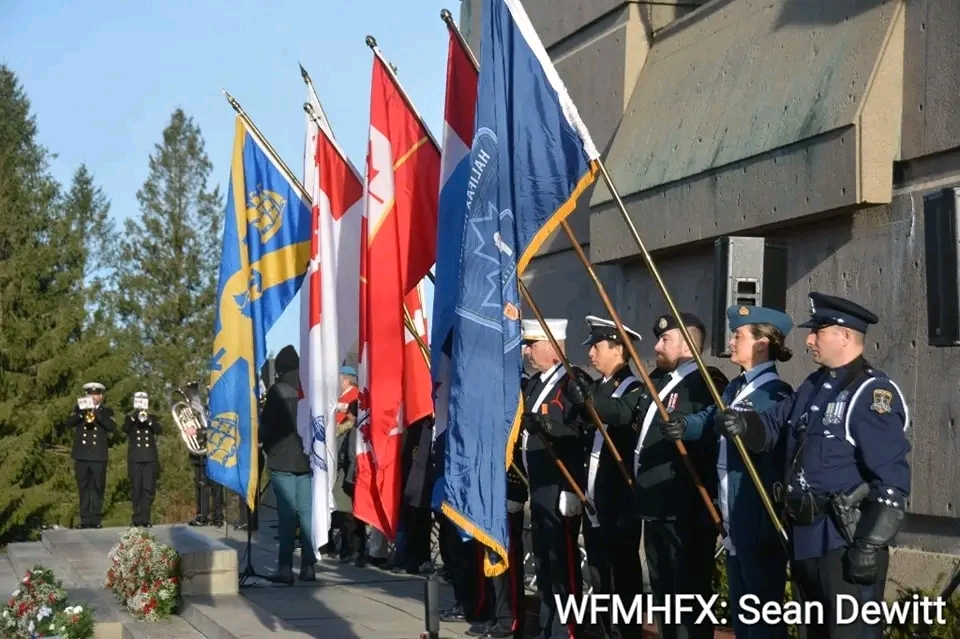**** Via HRM
The history of the Halifax Explosion
Thursday, December 6, 1917, dawned bright and clear in Halifax. World War I raged in Europe, and the port city was busy with the movement of war ships carrying troops, relief supplies and munitions.
Around eight that morning, the Norwegian ship carrying relief supplies to Belgium, SS Imo left its mooring in Bedford Basin and headed for open sea.
At about the same time, the French ship SS Mont-Blanc was heading up the harbour to moor, awaiting a convoy to accompany her across the Atlantic.
This small, barely seaworthy vessel was carrying a full cargo of explosivess stored in the holds and stacked on the deck.
SS Imo, a much larger and faster ship than SS Mont-Blanc, passed into the Narrows. She was travelling fast, and too close to Dartmouth when SS Mont-Blanc first spotted her. SS Mont-Blanc signalled that she was in her correct channel; SS Imo, however, signalled that she was intending to bear even further to port, closer to Dartmouth and further into SS Mont-Blanc’s channel. SS Mont-Blanc signalled again that she was still intending to pass to starboard; she was by this time very close to the Dartmouth shore and travelling “dead slow.”
SS Imo, however, did not swing towards Halifax, as SS Mont-Blanc expected; she signalled instead that she was maintaining her course.
SS Mont -Blanc, perhaps wrongly, saw only one course open — to swing to port, towards Halifax, across the bows of SS Imo, and thus pass starboard to starboard.
Perhaps the ships might have passed without incident, but SS Imo signalled “full speed astern.” So did SS Mont-Blanc, but it was too late. Reversing her engines caused SS Imo’s bow to swing right, and it struck SS Mont-Blanc — missing the TNT, but striking the picric acid stored directly beneath the drums of benzol on deck.
The impact cut a wedge in SS Mont -Blanc’s side, and struck deadly sparks.
The crew of SS Mont-Blanc, aware of their cargo, immediately took to the lifeboats, screaming warnings that no one heeded.
They rowed for Dartmouth, leaving the now furiously burning ship to drift towards Halifax, propelled in that direction by SS Imo’s impact.
SS Mont-Blanc drifted by a Halifax pier, brushing it and setting it ablaze. Members of the Halifax Fire Department responded quickly, and were positioning their engine up to the nearest hydrant when SS Mont-Blanc disintegrated in a blinding white flash, creating the biggest man-made explosion before the nuclear age. It was 9:05am.
Over 1,900 people were killed immediately; within a year the figure had climbed well over 2,000. Around 9,000 more were injured, many permanently; 325 acres, almost all of north-end Halifax, were destroyed.
Women view the devastation of the Halifax ExplosionMuch of what was not immediately levelled burned to the ground, aided by winter stockpiles of coal in cellars. As for SS Mont-Blanc, all 3,000 tons of her were shattered into little pieces that were blasted far and wide.
The barrel of one of her cannons landed three and a half miles away; part of her anchor shank, weighing over half a ton, flew two miles in the opposite direction.
Windows shattered 50 miles away, and the shock wave was even felt in Sydney, Cape Breton, 270 miles to the north-east.
There were about 20 minutes between the collision and the explosion at 9:05. It was enough time for spectators, including many children, to run to the waterfront to watch the ship burning, thus coming into close range.
It was enough time for others to gather at windows, and thus an exceptionally large number of people were injured by flying glass — 1,000 unfortunate survivors sustained eye damage.
Not surprisingly, hospitals were unable to cope with so many wounded.
There was also a desperate need for housing, and the misery was compounded by the blizzard that struck the city the following day, dumping 16 inches of snow over the ruins and their sooty, oily covering.
With astounding speed, relief efforts were set in motion. Money poured in from as far away as China and New Zealand.
The Canadian government gave $18 million, the British government almost $5 million, but most Haligonians remember the generosity of the state of Massachusetts, which donated $750,000 in money and goods and in volunteer assistance through the Massachusetts-Halifax Relief Committee.
Nova Scotia sends a Christmas tree to the city of Boston each year in gratitude.
Gradually, Halifax was put back together, though nothing could compensate for lost lives. Within two months over 1,500 victims had been buried, some unidentified; the remaining victims were discovered only in the spring as excavation was made easier.
A relief committee was set up to provide clothing, money and furniture.
Three thousand houses were repaired in the first seven weeks; in January, temporary apartments were being constructed at the rate of one every hour.
Rebuilding continued apace, and a few months later, construction started on 328 houses in the area bordered by Young, Agricola, Duffus and Gottingen Streets. The houses were built from cement blocks known as hydrostones, and (with a design unusually forward-thinking for the time) had gardens with trees in front, and modern plumbing and electricity.
This area, still known as the Hydrostone, is considered one of the more attractive and desirable parts of Halifax in which to live.
On Dec. 6, 1992, the Halifax Fire Department erected a monument in front of Station 4 (5830 Duffus Street, Halifax ), in honour of the nine members who died attempting to fight the fire on SS Mont-Blanc.
Ninety-nine years later, there are few survivors left to tell their stories. But Halifax has not forgotten, and every Dec. 6, just before 9 am, there is a service by the Memorial Bells at Fort Needham, close to where SS Mont-Blanc exploded.
A moving exhibit on the Explosion, “Halifax Wrecked,” can be seen at the Maritime Museum of the Atlantic, Lower Water Street. Maritime Museum of the Atlantic – Halifax Explosion.
See also “Shattered City: The Halifax Explosion and the Road to Recovery” by Janet F. Kitz.
National Archives of Canada – Virtual Exhibit: Tragedy on the Home Front




